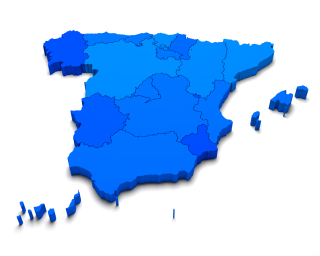iStock.com/Ermek
Posted by Jordi Baños-Rovira, Daniel Montolio and Clara Picanyol[1]
Spain is considered a highly decentralized country, where Regional Governments (called “Autonomous Communities”) manage around 31% of total public sector expenditure (Euro 224 billion in 2021 (19% of GDP)), providing healthcare, education, long-term care, and social services, among other services. The debt levels of Regional Governments have increased, especially after the 2008/09 global financial crisis, reaching 25.9% of GDP in 2021.
The importance of this level of government, and the fiscal challenges to be faced (fiscal consolidation, aging population and climate change) encouraged a research group from the University of Barcelona (UB) / Barcelona Institute of Economics (IEB) to conduct the first comprehensive study of the budgetary practices of the Regional Governments. This research was financed by the Spanish Institute for Fiscal Studies (IEF) in collaboration with the Independent Authority for Fiscal Responsibility (AIReF), Spain’s fiscal council.
The research was conducted during 2021 using a comprehensive survey of 15 of the 17 Regional Governments, covering 92% of total regional public expenditure. The results are presented in a report[2] that provides for the first time a comprehensive description of the current budgetary practices of Regional Governments in Spain, identifies areas of improvement, proposes 50 recommendations and highlights five best practices. The following points summarize the main findings of the study.
- Budget system
- Budgetary systems are mostly input-oriented, but with a performance orientation for presentational purposes.
- A medium-term perspective is a common feature, including multi-year budget revenue and baseline expenditure projections, but is not fully integrated into the annual budget.
- While some Regional Governments report carrying out debt sustainability analysis, they do not undertake long-term fiscal/budgetary projections.
- Individual Regional Governments usually prepare their own accounting standards and rules together with a detailed budget classification, including in some cases gender-sensitive expenditure tagging.
- The use of cost accounting is rare, mainly found in regional entities providing healthcare services.
- Budget formulation and approval
- Regional Governments are given at least 4 weeks to prepare their budget requests, and 3-4 weeks for budget negotiations with the central finance units.
- The complete budget preparation process generally takes about 9 months (starting in March), including scrutiny and approval by the Regional Parliaments.
- Macroeconomic and revenue forecasts largely depend on information provided by the Central Government, and Regional Governments usually do not carry out any fiscal sensitivity or risk analyses related to these projections.
- Few resources are allocated for external shocks or other contingencies (frequently less than 0.5% of total expenditures), leaving little buffer to deal with fiscal risks.
- Indicative annual budget ceilings are set, but only a few governments set multi-year ceilings.
- Performance information is not widely used in preparing budgets or monitoring their social and economic impact.
- The budget approval process allows the Regional Parliaments to make amendments at two stages: Stage 1 - global amendments; Stage 2 detailed spending amendments - where the totals approved in Stage 1 (revenues and aggregate expenditures by department/section) cannot be changed.
- Budget execution and outturn
- Expenditure estimates are approved at quite a high level of detail, thus hindering flexibility in executing the budget.
- Regional Governments apply quantitative (%) restrictions on the annual amounts of multi-year spending commitments.
- Systems for reporting on and monitoring budget execution and fiscal risks are quite extensive, but there is little attention to in-year program performance monitoring and to following-up the financial performance of public corporations.
- The use and publication of annual program performance reports is widespread, but policy evaluation tools and spending reviews are just emerging.
- Budget transparency and participation
- Much budget documentation data are publicly available. However, some important budget documents (pre-budget reports, citizens budgets, long-term budget outlook, etc.) are generally not published.
- Two-thirds of Regional Governments hold some hearings on the budget in which citizens and stakeholders may participate, but only one region conducts a fully participatory budget process.
Overall, the Spanish Regional Governments apply generally sound budget practices in which most of the fundamental elements, including a quite high level of transparency, are in place. In addition, several advanced practices have been introduced, but in some cases are still being fully integrated with the annual budget.
Recommendations
Finally, the issuance of 50 recommendations aims to contribute to the better management of public resources in the coming years. Among these, we would highlight those related to two issues:
- Strengthen fiscal discipline and the use of top-down, medium-term budgeting:
- Develop sensitivity analysis regarding macroeconomic and revenue forecasts.
- Allocate more resources to the regional contingency funds (1-3% of expenditures).
- Generalize the use of multi-year expenditure ceilings for spending areas/departments.
- Require the medium-term budgetary impact of budget requests to be estimated and provide guidelines and training for its development.
- Institutionalize periodic debt sustainability analysis and long-term budget projections.
- Reinforcement of performance orientation:
- Dedicate efforts to improve the quality of performance information.
- Reinforce the use of performance information within budget requests.
- Generalize the development of policy evaluation and spending reviews.
The intention is to provide continuity to this study, updating the information on a regular basis and comparing it against the baseline established in the 2021 report.
[1] Jordi Baños is a senior government financial officer and lecturer and collaborating researcher at the University of Barcelona/IEB; Daniel Montolio is a full professor in economics and researcher at the University of Barcelona/IEB; and Clara Picanyol is an international consultant in public financial management and collaborating researcher at the University of Barcelona/IEB.
[2] Available in Spanish in the following link
Note: The posts on the IMF PFM Blog should not be reported as representing the views of the IMF. The views expressed are those of the authors and do not necessarily represent those of the IMF or IMF policy.






